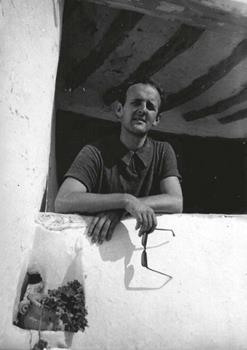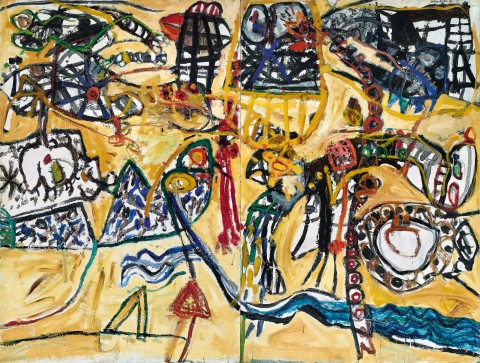SPANISH ENCOUNTER 2, 1960
JOHN OLSEN
oil on composition board (diptych)
182.5 x 242.5 cm overall
signed and dated upper right: John Olsen 60
signed and inscribed with title verso: John / Olsen / “Spanish” / “Encounter 2”
Rudy Komon Art Gallery, Sydney
State Bank of New South Wales, Sydney, acquired from the above in 1983
Corporate collection, Sydney
Introduction 1961, Gallery A, Melbourne, 23 February – 17 March 1961, cat. 37
17th Anniversary Show, Rudy Komon Art Gallery, Paddington, 11 December 1976
Spate, V., John Olsen, Georgian House, Melbourne, 1963, pl. 30, p. 18 (illus., dated as 1961)
Borlase, N., ‘Art’, The Sydney Morning Herald, 16 December 1976, p. 7
Spanish encounter, 1960, oil on hardboard (triptych), 183.0 x 366.0 cm (overall), in the collection of the Art Gallery of New South Wales, Sydney
OLSEN IN IBIZA.jpg

Attending the Julian Ashton Art School, life classes at the Datilo Rubbo School and later, the East Sydney Technical College, John Olsen’s studies in Sydney during the late 1940s and 50s provided him with a solid grounding for the development of a successful artistic career. John Passmore, his teacher at Ashton’s, had the greatest influence, introducing him to compositional principles based on a rigorous study of Cézanne, as well as emphasising, almost in contradiction, the expressive and intuitive possibilities of drawing. Passmore’s belief that art was a ’mystic vocation’1 was critical, an authoritative declaration of validity for the young artist and his fellow students. As Olsen later wrote, ‘he made me feel I was being introduced into something sacred.’2
In a review of Olsen’s first major solo exhibition, which took place at Sydney’s Macquarie Galleries in 1955, the critic Paul Haefliger wrote, ‘emerging from the countless ranks of students, [he] is so far the brightest hope for a new generation of painters … His disintegration of forms, his sense of corruption [and] … daring … make him an ideal candidate for a trip abroad.’3 This came to pass in December 1956, when, on Haefliger’s recommendation, Robert and Annette Shaw offered to sponsor Olsen, providing his fare to Europe and a living allowance in return for paintings which would be sent home for exhibition in Australia. Arriving in England, Olsen travelled to Paris spending some months at Atelier 17, the print workshop established and run by Stanley Hayter, before travelling to Spain, the country in which he would spend the majority of his three years overseas.
I remember stopping for lunch at a tiny fishing village, and there like a table cloth laid out upon the sand were long fishing nets – men and women dressed in black but barefooted, donkeys, carts, fishing baskets. Unlike France which seemed all air and atmosphere, this was figured in an air of symbolism, the shadows for example were more distinctive and fascinating than the actors who cast them. The yellow sand, the white village houses, the cart wheels in shadow reveal an intense atmosphere of surrealism. In an instant, I could understand the Spanish tradition [of] Zurbarán, Velasquez, Goya, Dali, Picasso.4
Spanish culture and the vitality of the Mediterranean lifestyle suited Olsen and the freedom to work, read, think and experiment in this environment had a transformative effect on the development of his art. The living, meandering line that is such a characteristic feature of Olsen’s art emerged during these years. In part a response to Paul Klee’s famous notion of drawing as taking a line for a walk, this new element introduced the spontaneity and feeling of drawing into his painting. It also enabled him to depict the experience of being in the landscape or a particular place, of moving through it, seeing it from above and observing it close up, all at once. From this time on, multiple viewpoints, calligraphic line and a lively application of paint combined to produce bold compositions which were largely, although not exclusively abstract, and pulsated with energy and life.
Spanish Encounter 2, 1960 was painted in Sydney soon after Olsen’s return to Australia and is closely related to the monumental three-panel work of the same name in the Art Gallery of New South Wales, one of the masterpieces of mid-twentieth Australian gestural painting.5 The triptych was painted in a burst of creative energy one night and represented, ‘a release and a resolution of the previous years’ expressed in ‘a conglomeration of shapes in the process of metamorphosis.’6 In this double-panelled painting, Olsen’s signature line merges with a similar array of symbolic shapes – arrows, stars, gridded forms – as well as elements which seemingly represent aspects of the landscape, such as the vibrant blue river that flows across the lower right corner. Dynamic intersections of line, shape and pattern, and the careful interplay of forms, at once balanced and irregular, bely the apparent speed with which Olsen worked on the panels, highlighting his mastery of intuitive composition and gesture. The palette is rich – sandy ochre and brown, dark red, blues, grey and touches of green – and more vibrant than most of the Spanish work, simultaneously recalling memories of Spain as well as suggesting the landscape and colours of Sydney.
With a career that has spanned more than seven decades, John Olsen is rightly hailed as Australia’s greatest living artist. A major work from the period which marked the beginning of his artistic maturity, Spanish Encounter 2 is a joyous testament to his ability to communicate things seen, felt and imagined in a single painted image.
1. Hart, D., John Olsen, Craftsman House, Roseville East, 1991, p. 9
2. Quoted from inscription on Olsen’s drawing of an elderly Passmore in hospital, John Passmore, 1987, pen and ink and watercolour on paper, 75.4 x 54 cm, National Gallery of Australia.
3. Haefliger, P., ‘Big Promise in Work of Painter, Sydney Morning Herald, 16 February 1955, quoted in Hart, op. cit., p. 17
4. John Olsen quoted in Hart, op. cit., pp. 37-38
5. Spanish Encounter, 1960, oil on three hardboard panels, 183 x 366 cm (overall)
6. Ibid., p. 51
KIRSTY GRANT
